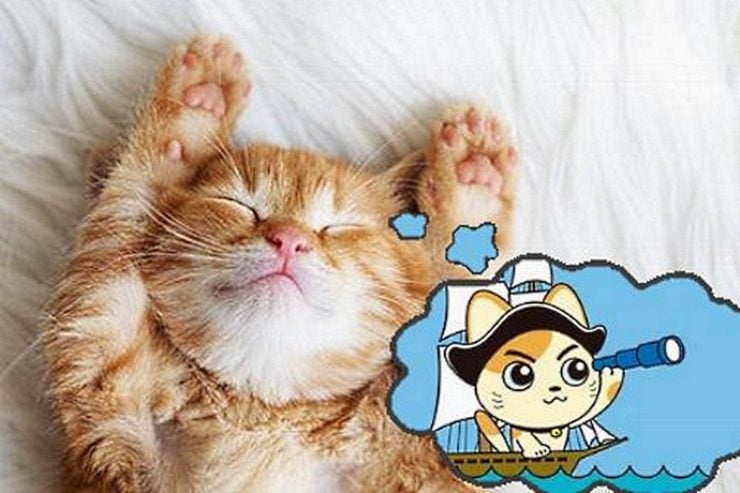Do cats dream? Most pet parents will swear that their cats do. They have seen their pets’ paws twitching while they sleep, so what else could it be if not a dream?

It sounds reasonable. But twitching of a cat’s paws or body, or even chattering, does not necessarily suggest that the cat has a dream. However…
Strong evidence indicates that cats experience dreams
Most likely, cats do dream, but at the same time, no one can know for sure. That statement arises from pure logic. After all, how do we know that people dream? Well, we can talk. We can wake up and confirm that, indeed, we had a dream.
Cats, on the other hand, can’t talk to tell us anything. Fortunately, we can examine what happens to us during our dreams and then see whether it happens to cats and other animals who can’t talk.
Is it possible to know whether cats dream?
Humans and cats undergo very similar sleep patterns. When both species fall asleep, they undergo a series of light sleep, deep sleep, and REM sleep, after which we usually either wake up or start a new cycle. The most substantial difference is that a full cycle for us takes about 90 minutes; for cats, it takes only 22 minutes.
REM sleep stands for “rapid eye movement” sleep, named so because our eyeballs move rapidly during this phase. What else happens? Humans have dreams during REM sleep. So, because cats have REM sleep, too, this suggests that they must have dreams. Right?
That’s correct, to a degree. The consensus is that cats most likely do dream, or, to be more precise, that there isn’t a single reason to believe they don’t. After all, humans and cats are not that different—we are all mammals, we have similar internal organs, and our brains function alike.
By the way, not only cats but all land mammals, all birds, and some reptiles experience REM sleep. Does this suggest that they all have dreams? Most likely, yes!
What do cats dream about?
If we cannot know for sure if cats dream, and guessing the topic of their dreams is even harder. We can’t assume that moving paws indicate a sleeping cat runs after a mouse in his sleep, can we? Our rapid eye movement during sleep doesn’t necessarily mean we’re having a dream about tennis, does it? It’s a twitch of muscles that not necessarily resemble the topic of a dream.
The mechanics of dreams characterizes them as a thinking process with some regions of the brain deactivated, mostly those responsible for movements and consciousness. This suggests that paw movements and eye movements must be initiated by a mechanism different from one that’s associated with running. Thus, it must be a reflexive response to brain activity.
Besides, we would otherwise observe a large variety of different movements during sleep. But we don’t, unless someone is sleepwalking, which is a neurological disorder.
Guessing the topic of our pets’ sleep is also complicated because we cannot project our dreams on them, either. Our thinking process is subtly different from theirs.
We often dream about something we know, have experienced, that we want, or that we are afraid of. We also often dream about things we have thought about a few minutes before we fall asleep.
But what about cats? Their minds aren’t preoccupied with serial killers or the political beliefs of our colleague’s grandmother. They also do not plan their future and probably aren’t wondering how the universe began.
As it happens with hunters—they often think about hunting. Modern pet cats also indulge in other activities, like playing, knocking glasses off tables, and boxing with the family dog. Cats likely think and dream about these and other events.
Besides differences in thinking, cats’ perception of the world around them is quite different from ours, and this also is a reason why we can’t project our experience onto them.
We often visualize our dreams and view them as a “movie,” but most of us will agree that this isn’t always the case. Sometimes, our dreams are blurry, uncertain, and very strange. People who are blind report fewer visual dreams and the number of visual dreams inversely correlates with the duration of a person’s blindness. People who are blind since birth report no visual dreams, for they don’t know what “visual” looks like.
Most cats, of course, are not blind. They have very low acuity (relatively compared to us), but this is compensated by improved contrast differentiation and night vision. But that’s only part of it. Their more reduced vision is also compensated by a strong sense of smell, which means that their dreams may be more olfactory than visual.
Taking everything into account, we can assume, with high certainty, that cats must have dreams. But we are far from answering what they dream about and how they see, smell, or “touch” dreams. Maybe cats experience dreams in a way that we won’t understand, at least for now. Check back in a decade or few.
